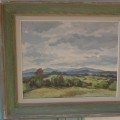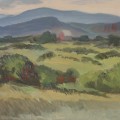Georges Campbell Tinning
Georges Campbell Tinning ( 1910-1996) Né à Saskatoon, il grandit dans les prairies, entre Winnipeg et Régina, les villes qui le virent s'intéresser aux classes d'art prodiguées dans ces endroits, pour poursuivre plus tard à L'école d'aquarelle de Goose Rocks et au Art Student's league de New York sous Arnold Blanche et William Palmer. Après la guerre, de retour au Canada, il s'installe pour de bon à Montreal, ou il expose régulièrement à l'art Association et devient membre de l'académie Royale des Arts du Canada. Peintre reconnu comme artiste ''officiel de guerre'', dû a ses aquarelles d'époque. il respecta plusieurs contrats tous aussi différents qu'intéressants, produisant simultanément Aquarelles et huiles, en plus de Gravures importantes sur la demande du Manoir de Baie comeau, côte Nord du Québec, il fût le peintre à représenter des paysages de différentes régions du Québec rural. Ses oeuvres se retrouvent dans tous les grands musées d'ici et d'ailleurs. Le tableau proposé par notre galerie est titré : Sutton, Cantons de l'est est une huile sur toile.
REF: Colin S. Macdonald
George Campbell Tinning achieved recognition for the watercolours he painted during WW II as an official Canadian war artist. He lived in Montreal and was known for his landscapes in watercolour and oils; he also completed mural commissions. As an artist, he was known simply as Campbell Tinning.
Born in Saskatoon, Tinning grew up on the prairies in Winnipeg and Regina. In the latter city he took art classes and participated in a group exhibition in 1937. In 1938, he attended the Eliot O'Hara Watercolor School at Goose Rocks, Maine and then went to New York to study at the Art Students League under Arnold Blanche and William Palmer.
When he returned to Canada in 1939, he settled in Montreal and was employed as a graphic artist by Robert Simpson Ltd., from 1940-42. The Art Association of Montreal awarded him the Jessie Dow Prize for his watercolour paintings in 1942 and in 1948.
In June 1942, Tinning enlisted with the Black Watch Royal Highland Regiment and was appointed an official war artist in April 1943. He painted in Nova Scotia and Newfoundland before going overseas. His first posting was at a Canadian Army parachute training school in England, and his watercolour, Drifting Down, 1944, depicting the 1st Canadian Parachute Battalion practicing in the Wylye Valley England, captured the gentle movement of the falling parachutes. This work has become one of his better-known paintings. In 1944 Tinning was posted to Italy, where he painted armoured units. He later went on to Holland and Germany, and was demobilized in 1946 with the rank of Captain.
After the war, Tinning returned to Montreal where he resumed his career as an artist and illustrator, he also taught watercolour painting at night. Tinning joined the Canadian Society of Graphic Art and the Canadian Society of Painters in Water Colour. In 1950, his watercolour landscape, Net Drying, Blow Me Down, Newfoundland, 1949, was purchased by the National Gallery of Canada. In 1953 he was elected an associate member of the Royal Canadian Academy of Arts, and in 1970 he became a full member.
From 1950 to 1969 Tinning was employed as an illustrator for the Ford Motor Company's magazine Lincoln-Mercury Times, travelling to different locations around the world to produce on-the-spot sketches of picturesque travel destinations, such as a Newfoundland fishing village for use as cover art or Florence, Italy, to accompany a magazine article.
Tinning also obtained contracts to produce window designs at Simpson's department store, a mural for the Maritime Bar in the Ritz-Carlton Hotel, and decorations for the Montreal Museum of Fine Arts ball. In 1960, he completed an industrially themed mural for the entrance lobby of Jenkins Valve Company Ltd., Lachine, and in 1961, a mural illustrating historic urban scenes for the Bank of Montreal's executive offices. In 1968, the Manoir Hotel in Baie Comeau, Quebec, commissioned him to create nine prints representing French-Canadian and Aboriginal legends.
In 1964, Tinning held a solo exhibition at the Jack Hambleton Galleries, in Kelowna, BC.
In 1973, after seeing his own work in the exhibition, Sicily / Italy 1943-1945, at the Canadian War Museum in Ottawa, Tinning wrote to the museum's Chief Curator, "[My watercolour] Canadian Graves at the Gothic Line, [1944], was done two days after the breaking of that line at Tomba di Pesaro… the olive tree (the symbol of peace) and the grey sky were there and possibly were fortuitous, but their message comes across. I have always hoped that perhaps one or two of the families of the men whose names are on the crosses may have seen this picture."
Tinning painted watercolours in a variety of styles and subjects, including landscapes of the Okanagan Valley in British Columbia and the Eastern Townships of Quebec, scenes of downtown Montreal, views of Newfoundland fishing villages, farms of rural Saskatchewan, floral still life, figurative 'abstracts' inspired by music, and the cities of New Orleans, and London, UK.
During the 1980s and 1990s his war art paintings were included a numerous group exhibitions such as Canadian Artists of the Second World War at the Robert McLaughlin Gallery, 1981, The Sweetest Spring at the Canadian War Museum, 1989, and Victory Parade: Canadian War Artists in Holland 1944-45 at the Legermuseum in Delft, Netherlands, 1991.
In 1994 Tinning held his last solo exhibition at the Dominion Gallery, Montreal, two years before his death. He died in Montreal on February 28th, 1996.
References
Artist's Documentation File, National Gallery of Canada Library and Archives.
Brandon, Laura. "Obituary - George Campbell Tinning, War Artist, 1910-1996." Canadian Military History. vol. 5 no. 2, (1996): 57-61.
"George Tinning", Canadian War Museum, website, http://www.civilization.ca (accessed January 16, 2008).
Newman, Marketa. Biographical Dictionary of Saskatchewan Artists: Men Artists. Saskatoon: Fifth House, 1994.
Oliver, Dean and Laura Brandon. Canvas of War, Painting the Canadian Experience: 1914-1945. Vancouver: Douglas & McIntyre, 2000.
Smith, Heather. The War Art of George Campbell Tinning. Moose Jaw: Moose Jaw Art Museum, 1999.
Steele, Bethel. "Musically Speaking", Kelowna Daily Courier, March 25, 1964.
Westbridge, Anthony and Diana Bodnar. The Collector's Dictionary of Canadian Artists at Auction. Vancouver: Westbridge Publications Ltd., 2003.
Judith Parker
Compiled January 2008
A Dictionary of Canadian Artists, volumes 1-8 by Colin S. MacDonald, and volume 9 (online only), by Anne Newlands and Judith Parker
National Gallery of Canada / Musée des beaux-arts du Canada
 VENDU - SOLD - Près de Sutton,Canton de l'est, Close to Sutton,easterntownship.
VENDU - SOLD - Près de Sutton,Canton de l'est, Close to Sutton,easterntownship.Medium : Huile sur masonite - Oil on masonite
41 x 51 cm. - 16 x 20 in.
Prix : $ 2,200.
 VENDU - SOLD - Près de Sutton,Canton de l'est, Close to Sutton,easterntownship.
VENDU - SOLD - Près de Sutton,Canton de l'est, Close to Sutton,easterntownship.Medium : Huile sur masonite - Oil on masonite
41 x 51 cm. - 16 x 20 in.
Prix : $ 2,200.
« Retour / Home

